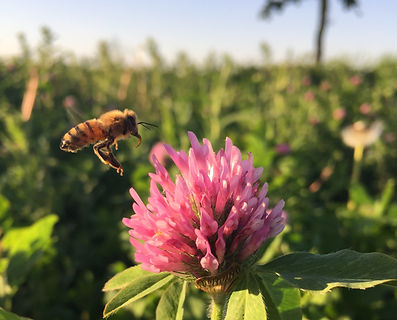We have fun doing science!
 |  |
|---|---|
 |
PHOTOS: SCIENCE IN ACTION


AN ENDANGERED SPECIES
The Giant Patagonian bumble bee, Bombus dahlbomii, has decreased by 80% in its native range in South America.

SEARCHING FAR AND WIDE
PI Amy Toth spent a year sabbatical in Argentina (2018-2019) studying the causes of decline of the rare Patagonian bumble bee.

THERMAL IMAGING
We are investigating whether differences in thermal biology may influence bumble bee species' survival, in Patagonia and Iowa.

PRAIRIE STRIPS FOR BEES
Bee hives kept in prairie strips produce more honey and grow larger than those in control sites.

FASCINATING BEHAVIOR
Polistes paper wasps are social and have surprising cognitive abilities. In a recent study we found they explore their own reflections in mirrors.

BEE COLLECTIONS IN THE FIELD
Grad student Erika Ibarra-Garibay collects native bees in the field while pollinators forage on prairie striips.

FORAGER IN FLIGHT
A honey bee forages on red clover, one of the most common sources of forage in IOWA.

PRAIRIE POLLEN
Honey bees in experimental hives have packed the comb full of diverse pollen.

HIVE INSPECTIONS
Former grad student Ashley St. Clair and undergraduate Zoe Pritchard record data on honey bee hive health in Iowa prairies.

RAINBOW NEST
This Polistes metricus wasp made her nest from colored construction paper, which we provided as building material.

WASP NEST BOXES IN THE FIELD
Are used in many experiments. Here, we simulated vibrational communication using piezoelectric devices.

WASP REARING IN THE LAB
Polistes paper wasps can be readily reared in the laboratory.

WASP NEST MAPPING
Is often used to track nest development. It is usually done at night, here by Amy Geffre.

PAINT MARKED WASPS
Are not only colorful, but useful! This allows us to track individual behavior.

HAND FEEDING WASP LARVAE
Using a pipetter is a handy way to deliver experimental treatments, such as drugs or dsRNA.

CHECKING BEEHIVES
Is a regular part of our work, so that we have healthy bees for experiments. PI Amy Toth pictured in a rare moment wearing a brand new beesuit. They don't stay clean for long so definitely a photo opp!

TEAM WORK
Happens a lot. Here, we were all pitching in to help paint about 10,000 bees in a day. Former lab members Zoe Pritchard, Jenny Jandt, Erin McCall, and Kate Hunter.

A MOBILE LABORATORY
Is sometimes needed to make collections at numerous field sites around Iowa.

BREAK OF DAWN
Monitoring wasp nests is substantially easier at dawn when all occupants are home and sleepy. Former lab member Colby Behrens pictured.

TRAINING NEW-BEES
We've introduced hundreds of new students to beekeeping! Alex Walton pictured demonstrating how to open a hive on a training day.

OBSERVING BEES
Much of our work involves inspecting and observing bees in the field. Pictured are PI Amy Toth and former postdoc Adam Dolezal.